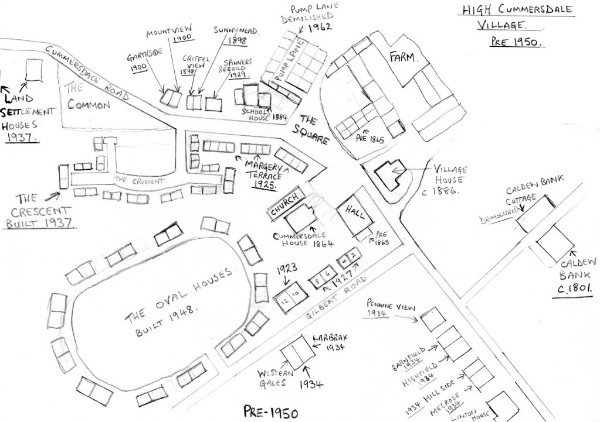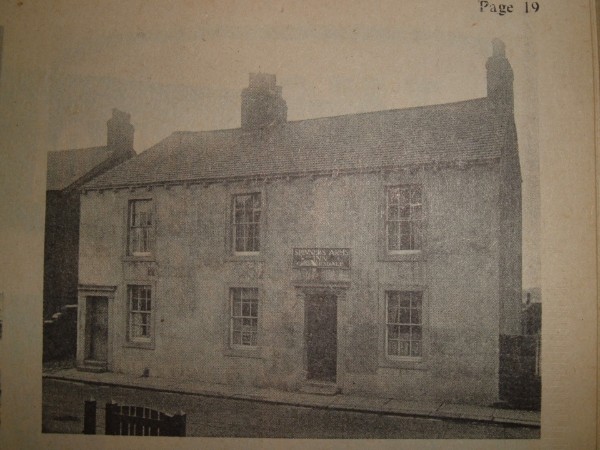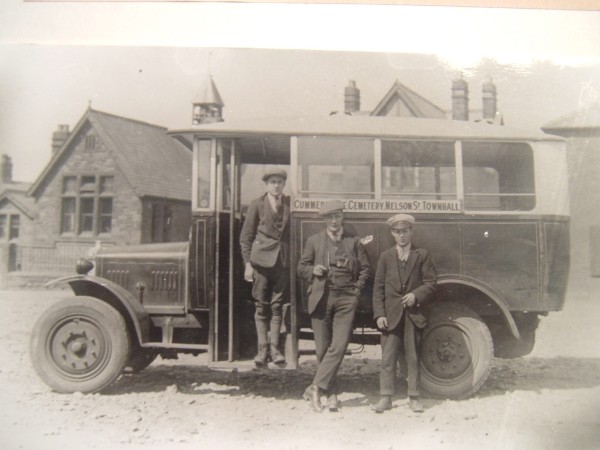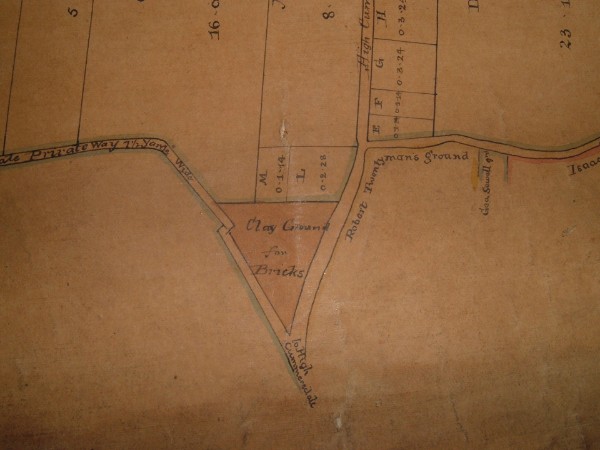
High Cummersdale.
The village of High Cummersdale was no more than a farm and a few cottages until the industry arrived at the bottom village (Cummersdale Mills) in the 1790s. The village increased in size with the building of more houses. The plan shows the chronology of how the village has grown up to 1950. By looking at early maps showing the top and bottom villages it can be seen that there were about 50 houses in High Cummersdale and about 45 in the bottom village. These were mainly terraced houses for the workers,(tied cottages). On the 1865 Ordnance Survey map, the only substantial houses were, Caldew Bank, Hill house, Cummersdale House and Mill House. The map shows a cluster of houses on the area which is now the Embassy Club (Village Hall), also amongst these was the "Coach and Horses",The first village pub.. A further eight houses existed at Pump Lane across the village square; these were demolished in 1962. Quite a few houses surrounded the farm, as they do today. Heading out of the village stood the Beerhouse, now the "Spinners Arms", itself two terrace houses. Next door to the Beerhouse was a cottage with a stable and other outhouses, and this was the sum total of dwellings in High Cummersdale in 1865.

The old Spinners Arms pub, this was demolished in 1930 after the new pub was built behind it.
The school and the school house were built in 1884, the Village House in 1886. The cottage next to the Beerhouse (Spinners) was sold to Thomas Hurst of Carlisle in 1898. He demolished the cottage and out-buildings and had two semi-detached houses (Sunnymead and Criffel View) built on the site. His brother, John Hurst, built a further two semi's next to them in 1900, (Garthside and Mountview). In 1923 an application was made to build two large semi- detached houses on Gilbert Road,(named after Gilbert Stead). Also in 1923 Stead McAlpin applied for planning permission to build 12 terrace houses,these were built in three blocks of four, as workers cottages. They were built with Goverment subsidy, and it wasn't until 1925 that they were actually constructed. They were given the name Margery Terrace, after Edmund Steads daughter. Stead McAlpin also applied to built four subsidised houses on Gilbert Road, two blocks of two, built in 1927. The village pub, the Spinners Arms, was rebuilt in 1929 and the existing pub consisting of two terraced houses, were demolished. In 1934, two more large semi- detached houses were built on Gilbert Road; Western Gales, and Larbrax. It was also in 1934 that houses at the top of the hill leading down to the print-works were built. At the bottom village, one of the rows of back to back terrace houses was demolished and the remaining row altered to a single row with better facilities. Some of the tenants were rehoused in 1937, when houses were built in the top village in what is now the Crescent. About the same time some Land Settlement houses were built in the Parish. The next substantial block of houses to be built was the Oval houses in 1948. Since then development has concentrated along Gilbert Road, except for the senior citizens' dwellings and the Croft beside the farm.

The modern Spinners Arms, built in 1930. The new pub was built directly behind old one, on the 29th June, 1930 the old pub closed and the following morning the 30th June 1930, the new Spinners Arms was opened. The new building was designed by Harry Redfern.

The original land settlement houses were built in the Parish in the late 1930's. This was not welcomed by the people of Cummersdale.

Primrose Cottage behind the village hall, now converted.

Heading towards the village square with a cottage on the left and the School straight ahead.
The Bacon Curing factory.
A Bacon Curing Factory once existed at High Cummersdale. In the Dean and Chapter archives in Carlisle record office situated in Carlisle Castle, are the Court Baron / Court Leet books for the ancient Manor of John de Chapple, which covers some areas within Cummersdale and Caldewgate. The books tell us of previous owners of the site and properties. An entry on 13th February 1747 records a property on the site consisting of a Messuage,(a house or cottage), a barn, byre and garden. This is the area where the present church, village hall and Cummersdale House stand today. Further entries record changes of ownership in 1767, and 1822. Al,so by 1827 Mr John Watson had become the owner of the properties and land. When John died in 1836, he left his property at Cummersdale to his only son, Richard. John had put a proviso in his will which allowed accomodation for his wife Sibyl:
"Subject to my said wife having the use and accomodation of two dwelling rooms(provided she lives in them herself, but not otherwise) called the Bakehouse rooms."
The reference to the Bakehouse rooms suggests there could have been a Bakery at Cummersdale in the 1830's.
It was'nt until April 1859 that ownership of the properties once again changed hands. This time the new owner was Joseph Smith, the son of Joseph and Ann Smith previously of Wigton. Born in 1821, his mother was one of the McAlpins, sister of Thomas and Duncan McAlpin, two of the founders of the Stead McAlpin company.
Joseph had moved from Wigton with his mother and sister shortly after 1835 and the 1841 census records them living at the printworks. Joseph mother, Ann ran the grocer's shop in the village and in the 1841 census she is recorded as a grocer and later in 1848 she is still recorded as the grocery shop owner at High Cummersdale. By 1851 Ann had given up her grocery shop to her son, Joseph, but he was still carrying out work for the printworks as well. In the 1876/77 directory Joseph is recorded as a grocer but two years later the 1879 Slater's directory records him as a bacon curer at Cummersdale. This is the first reference to the bacon curing at Cummersdale.
The present church building and the village hall were part of the bacon curing factory and the buildings stretched back to the roadside.

The Old Bacon Curing buildings with what became village hall, extreme left and Cummersdale House roof and
chimneys at rear and centre. The men sitting and leaning on the Wellie wall. One of the village wells is situated behind the wall.
The early Transport

One of the early buses that served Cummersdale. Note that the village square is still a cobbled surface.
In the early 1920's the Carlisle City council appointed a committee to look into the question of a municipal bus service
for the City and surrounding suburbs. The position at the time was that anyone with a small capital outlay could start up
a bus service once they had obtained a licence from the council.
Before the existence of the big bus companies that we know today, the local bus service was a one man, one bus operation.
They would run a service between the city and outlying districts and in addition to their passengers they would also carry
livestock, farm produce and all manner of things in and on their vehicles as part of the service. Even the passengers would
be dropped off near their doors, more like a taxi service.
The villagers of Cummersdale until 1924 had to either walk to Dalston Road and catch the Dalston bus which was run
by Mr W.E.Dixon, or they could walk to Holme Head or Denton Holme and take a tram to town, or catch a train at Cummersdale
Mills station, although this was a limited service.
It was in 1924 that Mr Fred Hart, who had been running a bus service from the golf course in Carlisle to Bellevue, decided that
a bus service to Cummersdale would be more profitable. So mid-way through 1924 he started his bus service to Cummersdale
village. The route taken at this time started at the town hall, then to Charlotte Street, Lorne Crescent, Blencowe Street, up Nelson
Street on to Dalston Road and then to Cummersdale villages. After a few days the route was changed by public demand. The
new route included Clifton Street, Colville Terrace, and on to Norfolk Street, along and up Richardson Street to Dalston Road
and on to Cummersdale.
In Mr Hart's haste to start the service he ommited to apply to the city council for the necessary licence to operate his service.
He had also upset a couple of other bus operators, Mr Dean, who ran the Dalston bus service, and Mr Parker, who ran a service
to Longsowerby, so it was inevitable that someone informed the counci lthat Mr Hart didn't have the necessary licence.
On the morning of September 12th as his bus left the town hall he was stopped by the Inspector of Hackney Carriages for the
city and his vehicle was taken ut of service. The service had proved so popular in such a short time that a petition was raised by
villagers and people along the route, which resulted in a successful application, and Mr Hart resumed his service on September 24th.
The service ran every half hour with a fare of tuppence ha'penny single fare and fourpence for a return ticket. It was one penny from the
town hall to Denton Holme and three halfpence to the cemetery gates.
Another bus operator, Mr Harry Hayton, also applied for the same Cummersdale service in November and was successful. Harry Hayton
was in partnership with William Smith for a short while. Their bus was a 13-seat Morris. Fred Hart's bus was a 13-seat Chevrolet and his
company was known as the Blue Bird Bus company. Harry Hayton's bus was known as the Red Bus. The only complaint I found about
the early service was in October 1929, when the parish council sent a letter to Mr Hart of the Blue Bird Bus company requesting that the
bus stay awhile in the village and the driver blow his horn as he entered the village and again when he was about to leave. It must be
remembered that the bus service route also covered the bottom village as well.
After the city tram services were stopped in November 1931, Ribble Motor Services took over most of the city routes. At hat time the
Cummersdale service (No48) which was being run by Carlisle and District Motor Services(formerly Fred Hart's Blue Bus) and Harry
Hayton's Red Bus(No47) became part of the Ribble Motor Services, with 20-seater buses.

An early Charabang trip from the village.

The Common as you enter the village, set aside for brickmaking, it was known locally as the Brickhills or the clay pits.
.